Table of Contents
Best Bushes for Small Gardens
Bushes are a staple in most gardens, as they can be used for everything from creating a border, lining a driveway or path, or creating privacy from neighbors or passer-by traffic.
Bushes are also known as shrubs, and many people with smaller gardens don’t think about them as a good option for planting, as they don’t usually have as much space as many bushes need.
Some of the better-known bushes can grow upwards of 10 feet when not pruned.
But for those of us who have smaller gardens and still want the beauty, efficiency, and privacy that bushes can provide, there are plenty of options out there that will be easier to manage and not take over all of your space.
The best bushes for a small garden will have something to offer visually every season and will be easy to maintain and keep under control. The bushes on this list also tend to be easy to plant and care for, since those of us with smaller gardens won’t have the option to experiment as much as people with larger pieces of land.
One thing to keep in mind before you start planning and planting is this – all bushes (like all foliage) fall into different hardiness zones.
In the United States, each plant is given a number, which signifies what conditions need to be in place in order for it to grow to its best potential. These are called hardiness zones and the United States is broken into 11 zones, with each growing zone being 10°F degrees warmer than the one before it.
Knowing what zone you live in will go a long way in helping you determine which bushes will grow best in your small garden. Not all plants have to fall perfectly within your zone to do well, but it is advised that you at least take into consideration your zone so you won’t be disappointed if something you plant does best in a zone that is well outside of the zone in which you live.
All the plants on my list have their optimal zones listed, so it won’t be difficult for you to decide on the ones that will be happiest where you are.
1. Japanese Holly (Ilex crenata)
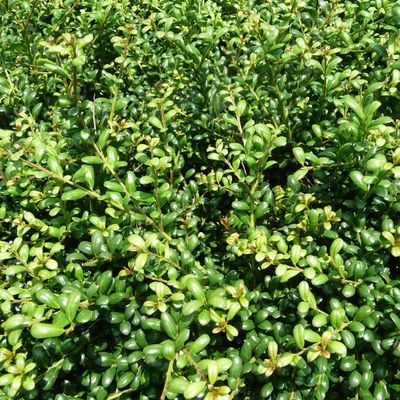
Japanese Holly (Ilex crenata)
The Japanese Holly is, as the name implies, a holly bush that is native to Asia, but has been gracing small gardens in the United States for over 100 years.
Known for their boxy shape (similar to a boxwood) these bushes are widely popular because of their ability to grow large and give more privacy, or be kept contained and low to the ground. They are often used for covering foundations since they grow in such a dense pattern that they can make something unsightly basically disappear.
It’s also important to note that the Japanese Holly is toxic to humans and pets, so it’s best to keep these bushes in places where there is low to no human or pet traffic. Bees and birds, however, love the Japanese Holly.
The Japanese Holly is known for its small white flowers that appear in the early part of spring, and its dark green, almost waxy-like leaves that stay beautiful all year long.
These gorgeous evergreens can grow to be as big as 10 feet but are easy to keep at heights as low as 3 to 5 feet. The Japanese Holly tolerates frequent pruning and cutting these growers back from time to time throughout the year will not affect their health.
These hardy garden helpers will do best in hardiness zones between 5 to 8. They will do better in the higher temperatures, but as long as you mulch them well before winter, they can handle some colder climates. They are also extremely drought-resistant.
The Japanese Maple can tolerate partial sun, though they will thrive best with at least six to eight hours of sunshine a day. Another reason they are great against a foundation is that they don’t mind partial shade, especially later in the day.
2. Daphne Eternal Fragrance (Daphne x transatlantica)
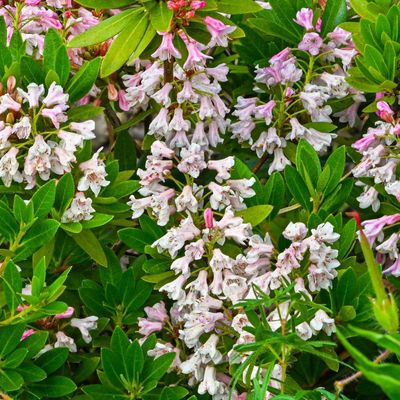
Daphne Eternal Fragrance (Daphne x transatlantica)
If you are looking for something compact, easy to care for, and full of smell and blooms, the Daphne Eternal Fragrance is the bush for your small garden.
The names of this plant didn’t have to get very imaginative. The Daphne Eternal Fragrance gives off a lovely scent from early spring all through the early fall.
It will also continue to produce small, pale pink flowers during all three of these seasons and will stay green even during winter unless you live in a climate outside of its hardiness zone.
The Daphne Eternal Fragrance rarely gets above 4 feet tall and doesn’t really need pruning, making it the ideal bush for smaller gardens. Its constant blooming ability through spring, summer, and fall also means you won’t be without something to look at if this bush is part of your yard.
These beauties can grow well in hardiness zones between 4 and 9 but may start to lose some of their leaves in the winter if they are planted in the lower zones, depending on how harsh the winter weather is.
One downside to the Daphne Eternal Fragrance is they are not as long-lasting as some of the other bushes on my list and will need to be replanted every 5 to 6 years, depending on how harsh your climate is. But their beauty is well worth it.
Another plus to these plants is that they do well in shade to partial shade areas, which is good news for gardeners who struggle to find foliage that will not just survive but actually thrive in shady garden spots.
3. Magic Carpet Spirea (Spiraea japonica Walbuma)
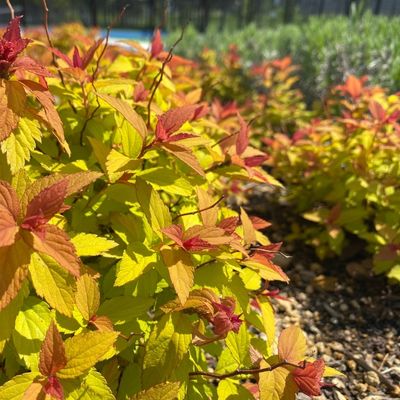
Magic Carpet Spirea (Spiraea japonica Walbuma)
Another great option for small gardens is the Magic Carpet Spirea.
These little bushes grow in tight mounds and will rarely reach more than 18 to 24 inches tall. They spread well, so they are terrific for areas of your garden that need some filler and can adapt to a lot of different areas.
The Magic Carpet Spirea is part of the Rosaceae family, of which there are over a hundred varieties.
They are easily identified because of their gorgeous gold leaves that will turn to a radiant red in autumn, giving your small garden a fall feel and plenty of colors during the time of year that many of your other plants will start going dormant for winter.
This showy little bush is easy to care for and ideal for small spaces and gardeners who may be new to the game. Its leaves will turn from pale green in the spring to that fiery red by fall. In June, the Magic Carpet Spirea will produce tiny pink flowers that contrast nicely against its ever-changing leaf color.
As I mentioned earlier, the Magic Carpet Spirea is a great, low-to-the-ground shrub that won’t grow taller than 18 to 24 inches. It doesn’t require much in the way of pruning, but after it blooms you may want to trim it back slightly to keep it from taking over other plants in your garden because it does like to spread.
Trimming it back may also allow for another bloom to occur later in the summer, especially in warmer hardiness zones.
The Magic Carpet Spirea will flourish in hardiness zones 3 to 8, meaning it is one of the most adaptable and hardy bushes on my list. The only area this bush may not do well is in the far southern United States.
You can plant these bushes in anything from full sun to partial shade. They also don’t require a ton of water and – though they prefer well-drained soil – they can adapt to different kinds as well.
If you are looking for tons of color, especially in the fall, think of adding the Magic Carpet Spirea to your small garden. The butterflies will also thank you.
4. Euonymus (Euonymus alatus)
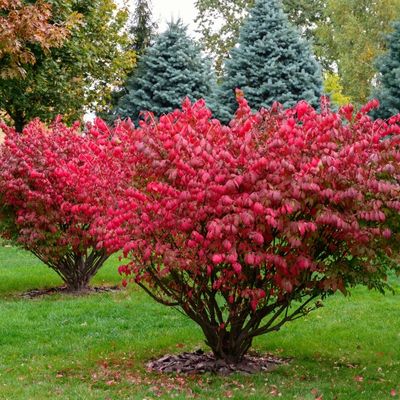
Euonymus (Euonymus alatus)
The Euonymus is a steadfast bush in all gardens and is particularly popular in small ones.
Also known by many gardeners as the Burning Bush for its gorgeously intense fall foliage and how it can go from almost one color to the next seemingly overnight.
The Euonymus bush is great for gardens, as it can adapt to a small piece of land or a large one, depending on what variant you buy, and how aggressive you want to be with pruning it.
Many lovers of this bush will say that – even better than its intense colors is its versatility.
For a plant so aesthetically pleasing, it’s amazing how low maintenance it is as well, which is especially nice for those of us who have minimal garden space and minimal time.
These bushes are capable of growing anywhere from 12 inches tall to 12 feet, depending on which variety you choose and where you plant them. Some variants need very little pruning in order to stay small. Others will need aggressive cutting to maintain a smaller size for your small garden.
The Euonymus is often referred to as the “backbone” of a well-landscaped and thoughtfully planned garden space because of its versatility and ability to fit in anywhere. They are like the chameleons of a good outdoor space!
Euonymus bushes will perform well in hardiness zones between 5 to 9, which means they will flourish in most parts of the United States, except for places with extreme temperatures.
For those who want to plant Euonymus bushes but live in colder climates, consider wrapping their trunks in burlap before the first frost to protect them from extreme elements. Otherwise, they will still most likely survive, but you won’t get quite the display of color in the fall.
From sand to clay, you should not have any trouble getting these burning beauties to grow. They will also do well in full sun or partial shade.
It’s hard to think of anything that would make the Euonymus a difficult sell for a garden, even a small one. Their beauty and effortlessness will not disappoint.
5. Rhododendron (Rhododendron ponticum)
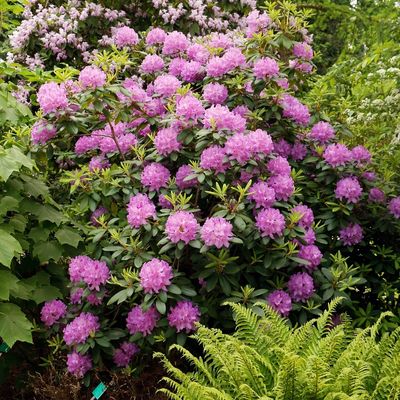
Rhododendron (Rhododendron ponticum)
Another definite show stopper for any small garden is the classical beauty, the Rhododendron.
There are over 1200 varieties of Rhododendrons, and they come in almost as many sizes!
You can purchase Rhododendrons that will only grow a few inches tall to ones that can be as tall as 100 feet, though most fall somewhere within the 3 feet to 6 feet size (thankfully!)
One of the Rhododendron’s biggest perks is the vast amount of colors that its flowers will produce. You can choose from bushes that will have anything from white and pink flowers to bright orange or deep red. If you need more color in your small garden, Rhododendrons may be just the thing, as their colors are so varied.
Rhododendrons tend to bloom from early spring to early summer, but can sometimes bloom until fall if the conditions are right.
These popular bushes are best when they are grown in hardiness zones between 4 and 8, but will thrive best in the warmer end of those zones. Though they don’t need a ton of sunlight and can actually grow quite well in shady conditions, they do need a good amount of rainfall, and do best in places where the spring and summer weather tends to be wetter than normal.
Rhododendrons prefer soil that is extremely moist and slightly acidic – again, elements that align with areas in the country that tend to be wetter and have milder summers.
Whereas many of our favorite shrubs will start to suffer when the sun hasn’t shined for a few days, the Rhododendron prefers it. In fact, this big bloomer will thrive during seasons when the rest of your plants are looking water-logged. Yet another great reason to consider a Rhododendron bush or two for your small garden, especially if you live in a place that receives a decent amount of cloudy days and rain.
6. Rose (Rosa)
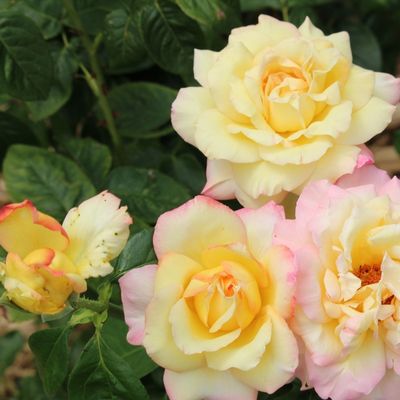
Rose (Rosa)
An ideal bush for small gardens is the well-known (and well-loved) Rose bush.
Roses have typically had a reputation for being difficult to grow, and sometimes this is true, depending on where you live and how you care for them. But, with the proper environment and some work, these beauties can be a perfect addition to your garden.
As you probably already know, Rose bushes come in an infinite number of varieties, colors, and styles. For a small garden, miniature Roses might be ideal, but even a regular Rosebush can be kept small, especially if you’re willing to put time into pruning it.
Rose bushes can be as small as 2 feet and easily grow against a wall, along a walkway, or climbing up the side of a structure.
One of the great perks to Rose bushes is that they will bloom all season long if given the right amount of care. Be sure to keep your Roses well-watered and dead-head blooms to encourage the growth of new ones.
Roses like sunshine and well-drained soil. They are made to grow well in hardiness zones 4 to 8, which makes them a popular bush for most of the country to grow.
The only climate that is a real challenge for Roses is subtropical, so they may not do as well in hot, humid areas of the country.
Roses also do very well in containers, which is another reason they are a great addition to small gardens.
Recent Articles

















